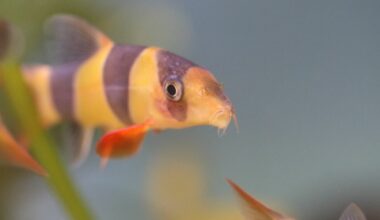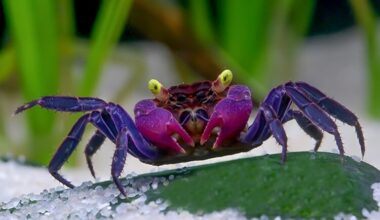The Powder Brown Tang could be a great addition to your saltwater tank as long as you are aware of its needs and high maintenance requirements. Their immune system is not too good so you have to make sure the water conditions remain consistent.
Another thing to keep in mind is their semi-aggressive behavior toward members of their species and other similar-looking Tangs so it is sometimes better to be kept alone. This guide covers everything you need for your Powder Brown from diet and tank requirements, to mates and breeding so lets get started!
Table of Contents
Species Summary
Powder Brown Tangs (Acanthurus japonicus) are a unique species of Surgeonfish that provide excellent visual contrast to community tanks. This species inhabits reefs, lagoons, and seaside areas across the Western Pacific, particularly off the coast of Japan, and warm reefs across the Indian Ocean, particularly near the Philippines and Taiwan.
These fish are usually found between 16 and 25 feet below the surface in small groups or large schools. Divers often spot them in exposed areas because the fish are comfortable swimming in clear water. Biologists consider Powder Browns semi-aggressive, making them one of the more docile Tang species.
Nicknamed Japanese Surgeonfish and Powder Black Surgeons, these fish are active swimmers and herbivorous. They possess many behavioral quirks and immune vulnerabilities common to other Tangs. Powder Browns are a semi-difficult fish to keep that will reward you with valuable tank clean-up.
Appearance
Powder Browns have the flat body type and oval-like shape characteristic of all Surgeonfish. True to their name, they are primarily brown. However, your tank lighting can cast them in more of a grayish hue. They have a white mark extending from below each of their large eyes to their mouth.
These fish have yellow bands running along the top of their bodies and bellies that meet at the caudal. The yellow markings create a wishbone-like pattern framing the fish’s body. The dorsal fin, which runs from the fish’s head to its tail, is a darker brown than the body and features an electric-blue edge. They have an orange strip across the brown part of their dorsal fins.
The pectoral and anal fins are also dark brown, with the same blue edging as the dorsal fin. The tailfin is a blended brown and blue pattern, browner near the body and bluer near the ends. The tips taper to points and are deceptively sharp.
Author Note: Like all Tangs, Powder Browns have a long spine extending from each side of their caudal peduncle. The fish use these structures to assert themselves in territorial conflicts with other Powder Browns and for defense. The appendages are not as prominent on Powders as on many other Tangs. Nevertheless, it’s essential to handle these fish with care when moving them between tanks or reaching into your aquarium to perform maintenance.

Lifespan
In the wild, a Powder Brown can have a lifespan of over 20 years and in captivity about seven years. Their poor immune systems compromise their longevity. Juvenile Powders have lighter brown bodies with yellow fins. They lack the white stripes on their faces.
Average Size
The average size of a Powder Brown is about 8 inches. There is no significant size difference between males and females. Powders are one of the smaller members of the Tang family.
Powder Brown Tang Care
These fish are moderately difficult to keep and require consistent water conditions and active surveillance due to their poor immune systems. However, they typically do well in captivity if you effectively acclimate them and keep them content and nourished.
Experts suggest always asking to observe your Tang feeding when you purchase it. Appetite loss is one of the first signs of illness and poor health. In addition, you can ensure the wild-caught fish accepts simulated feedings.
Tank Size
Your Powder Tang requires a minimum tank size of 125 gallons. Longer tanks are preferable because they create more open space for swimming and simulate the fish’s natural habitat. As with most fish, the bigger the tank, the better.
Water Parameters
- Water temperature: 73 to 78° F
- pH levels: 8.1 to 8.5 pH
- Water hardness: 8 to 12 dKH
- Specific gravity: 1.021 to 1.026
Tank Setup
The key to Powder Brown tank setup is balancing their need for open water to swim through with creating enough areas for them to hide. Populate your aquarium with plenty of live rock, but establish adequate shelters and crevices when laying out the material. A sandy substrate is ideal because these Tangs will comb the tank floor throughout the day as they look for algae.
Filtration
You need a powerful enough filtration system to handle your tank’s volume and stabilize levels. Swings in water conditions will stress your Powder Brown Tang. It is also essential to invest in a quality powerhead. This device will establish a strong current, which your active Powder will enjoy, and oxygenate the water.
Acclimation
The hardest step to housing a Powder Tang is acclimating them to your setup. They are needier than other Tangs in this regard. Most experts agree that your fish will thrive as a tank inhabitant if it survives the transition.
It is best to acclimate them to the destination tank using the slow drip method over several hours. Powder Browns also seem susceptible to stress and overstimulation, so quarantining them in a holding tank with less activity before introducing them to the eventual community tank is ideal.
This fish’s susceptibility to ammonia burns on the gills and fins complicates its acclimation. The compound is present in fish waste. When transported or shipped, the buildup of this material can harm the Powder, causing red gills and tissue deterioration.
Author Note: If you obtain your fish online and have it shipped to your home, begin the acclimation process immediately and closely monitor your Powder for damage to its gills. Establishing proper pH levels in the quarantine tank and administering anti-bacterial treatments are the best way to manage ammonia burns.
Are Powder Brown Tangs Reef-Safe?
Yes, if you are looking for reef safe fish the Powder Brown is one of them! They will not nip at or harm coral polyps or the invertebrates that inhabit your reef. As with all active swimmers, it’s best to ensure your corals are anchored and secure to prevent physical damage from this large active fish inadvertently disrupting the setup.
Common Possible Diseases & Prevention
Like their fellow Tangs, Powder Browns lack the protective layer of slime that shields many fishes from parasites. As a result, they are vulnerable to Marine Ich. The infection creates white blotches across the fish’s body and fins. The earlier you catch the disease, the easier it is to treat.
Author Note: If you spot signs of illness, optimize your tank’s water conditions and begin treatment with an over-the-counter anti-parasitic.
These fish are also prone to Head and Lateral Line Disease (HLLD). This condition, resulting from malnutrition, causes open wounds across the fish’s body or on the sides of its head. While often fatal, early detection is the key to recovery. When you spot HLLD, begin increased feedings and provide vitamin supplements to fortify your fish.
Preventing disease in your Powder Brown requires maintaining consistent water conditions and conducting routine water changes. In addition, your fish’s resilience relies heavily on its mood. Content and well-fed fish are more durable than ones that are stressed. Monitor your fish’s behavior, vary their diet, and ensure they have adequate space to maximize their overall wellness.
Food & Diet
Powder Browns are herbivores who eat marine plants and algae, especially benthic algae. They prefer multiple small meals per day. Your tank’s live rock will create prime conditions for natural algae growth. In addition, you can grow algae in a refugium or purchase frozen plant preparations.
Placing plant material or nori in the tank using a feeding clip allows your Powder to graze as it would in the wild. This method will help manage stress and keep your fish content. These fish will also accept plant-based pellets, adding to the variety of their meals. It’s critical to observe your Powder during the feedings. Their relative passivity and smaller appetites can increase the chance of malnutrition.
Author Note: Offering multiple small feedings daily and varying your fish’s options will keep them engaged with their simulated diet.
Behavior & Temperament
Powder Browns are considered one of the more peaceful Tangs, but they will still display aggression when provoked or if they feel their territory encroached upon. They are active fish who will explore every level of the tank and graze throughout the day, making food clips and live rocks essential for proper nutrition.
Your Powder will comb for algae on rocks, tank walls, and equipment. Their mouths are adapted to their tiny food sources and will not cause damage while feeding. Their cravings for algae help keep your tank clean.
These fish do best when kept alone. They are aggressive toward members of their species and other similar-looking Tangs. Fights with their scalpel-like appendage can be lethal. Beyond these territorial conflicts, they are peaceful community fish that coexist well with other species. Their gradual eating style and docile nature make them candidates for bullying from larger predatory fish.
It’s best to ensure your Powder is one of the last inhabitants you introduce to your tank. While generally passive, they are more assertive once established residents and may exert themselves against new additions.

Powder Brown Tang Tank Mates
Powders are great for community tanks that lack other Powders or similar-looking Tangs. They also leave crustaceans and invertebrates alone. Viable tank mates include:
- Banggai Cardinalfish
- Bicolor Angelfish
- Cleaner Shrimp
- Diamond Gobies
- Engineer Gobies
- Fairy Wrasses
- Flame Angelfish
- Marine Bettas
- Ocellaris Clownfish
- Pajama Cardinalfish
- Tomato Clownfish
Breeding
Captive breeding of Powder Browns is impossible in a home tank. These fish are open-water breeders. Males and females release their genetic material, which drifts in the current before uniting. Larvae then develop at the ocean surface before maturing to the stage where they can return to the reef.
The difficulty in sexing these fish and the tank size needed to house more than one Powder Brown prevent home breeding. These fish are now commercially bred, but most specimens available for purchase are wild-caught because spawning these fish is challenging, and they are easy to collect from the ocean.
Wrapping Up
Caring for a powder brown tang is not as complicated as it may seem at first. By providing them with the right environment, diet, and attention, you can enjoy the beauty and charm of this fish for many years to come.
Overall, taking care of this amazing fish can be a rewarding and fulfilling experience. With a bit of effort and attention, you can provide a comfortable and happy home for your brown. Remember to enjoy the process and take pleasure in the vibrant colors and playful personalities of your powder brown tangs. We hope this guide helped you and we wish you best of luck!

